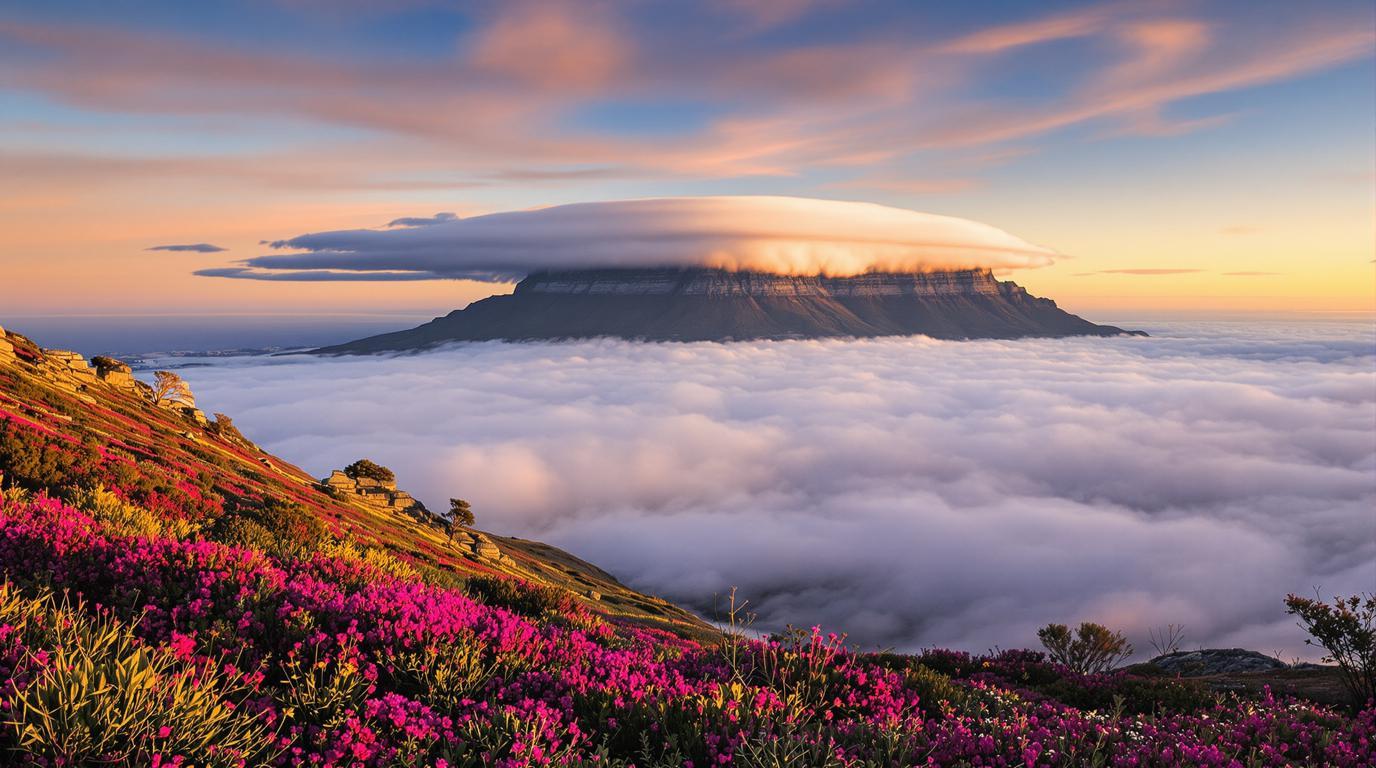South Africa’s iconic Table Mountain rises like a sentient fortress above Cape Town, drawing over 800,000 visitors annually to its ancient flat-topped summit. While most travelers recognize its distinctive silhouette, few realize this 600-million-year-old formation is home to more plant species than the entire United Kingdom—despite covering just a fraction of the land area.
A natural wonder with its own weather system
Table Mountain doesn’t just dominate Cape Town’s skyline—it creates its own microclimate. The famous “tablecloth” of clouds forms when southeastern winds push moisture up the slopes, condensing into a dramatic white blanket that spills over the plateau’s edges. This phenomenon once guided ships around the Cape of Good Hope centuries before modern navigation.
Local guide Thomas Makhanya explains:
“When the tablecloth appears, we say the mountain is smoking its pipe. Old sailors knew to take shelter when they saw this—the mountain was communicating with them.”
The aerial adventure that transformed accessibility
While hiking remains popular via routes like Platteklip Gorge, the Table Mountain Cableway offers a thrilling alternative. Since 1929, these rotating cars have transported visitors to the summit in just five minutes, with each cabin completing a full 360° rotation during the journey, ensuring panoramic views for all passengers.
The cable car operates daily unless high winds create unsafe conditions—a regular occurrence that locals call “mountain weather.” Always check the forecast before planning your ascent.
Home to Africa’s rarest amphibian
Among the mountain’s extraordinary biodiversity hides the critically endangered Table Mountain Ghost Frog, found nowhere else on Earth. These tiny, translucent amphibians inhabit the mountain’s hidden streams and seepages, making them one of the planet’s most geographically restricted vertebrate species.
Conservation biologist Dr. Sarah Daniels notes:
“These frogs have survived here since before humans walked the Earth. Their entire world exists on this single mountain—making them perhaps our most precious ecological indicators.”
The secret forest hidden within stone
While the summit appears barren from a distance, Skeleton Gorge reveals a startling surprise—a lush Afromontane forest tucked into the eastern slopes. This hidden woodland feels transported from another continent, with ancient yellowwood trees creating a cool, misty sanctuary from the South African sun.
This magical forest journey connects to other remarkable African landscapes worth exploring beyond the mountain.
A summit plateau larger than expected
First-time visitors often express surprise at the mountain’s expansive summit—nearly 3 kilometers long and home to reservoirs, hiking paths, and diverse ecological zones. The plateau takes approximately two hours to explore properly, revealing dramatically different environments across its sandstone surface.
Like America’s hidden lake paradises, Table Mountain’s summit reservoirs create unexpected aquatic environments in this seemingly arid landscape.
The indigenous defenders of the mountain
Long before European colonizers arrived, the indigenous Khoi people called this mountain “Hoerikwaggo” (Mountain of the Sea). They considered it sacred ground, with legends telling how the mountain was built to imprison a giant sea monster that threatened their coastal villages.
Today, spiritual guide Khoisan Aubrey shares:
“Our ancestors understood this mountain as a living being with its own spirit. When you stand here, you become part of a conversation spanning thousands of years.”
This connection to ancient spiritual practices recalls similar sacred sites in medieval France where natural wonders became intertwined with human spirituality.
The underground world beneath your feet
Table Mountain contains over 100 documented caves carved into its sandstone heart. These range from shallow overhangs to complex systems extending hundreds of meters into darkness. Woodstock Cave, visible from the city below, once sheltered indigenous hunter-gatherers who left rock paintings dating back thousands of years.
For those fascinated by underground wonders, Catalonia’s hidden mining towns offer similar subterranean adventures.
Where oceans collide at Africa’s edge
From Table Mountain’s summit, keen-eyed visitors can witness one of oceanography’s great spectacles—the meeting of the Atlantic and Indian Oceans. This convergence creates dynamic marine environments where great white sharks thrive, similar to Mexico’s remote shark-watching islands.
Standing atop this ancient promontory, you become part of Earth’s ongoing geological saga—a witness to the forces that continue shaping our planet and the resilient ecosystems adapting to its ever-changing face.
